Page Lapel Pin
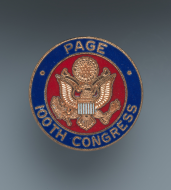 /tiles/non-collection/2/2008_155_000PQ1.xml
/tiles/non-collection/2/2008_155_000PQ1.xml
Lapel pins were long a part of Pages’ uniforms. This example dating from the 100th Congress take stylistic cues from Members’ lapel pins, with a round format and House seal in the center. The Pages position and the Congress’ number surround the seal. The lapel pin was not worn alone: a dress code handbook from this period shows properly outfitted pages wearing this pin above a black name tag.
Page Uniform
 /tiles/non-collection/2/2011_086_002PQ1.xml
/tiles/non-collection/2/2011_086_002PQ1.xml
This blue wool Page uniform, which boasts a mandarin collar jacket, full-length trousers, and suspenders, belonged to Roy Tasco Davis, Jr., a House Page in 1907. “Page” is emblazoned on the jacket’s stand-up collar. The look of this uniform is inspired by military styles of the period and differs from other Page costumes of the early 20th century. Pages were often photographed wearing knickers—short pants usually reserved for children or sporting pursuits.
Collection of the U.S. House of Representatives, Gift of Todd Lowe, Roger Lowe and Nancy Lowe, Grandchildren of R. T. Davis, Sr.
About this object
House Page Uniform
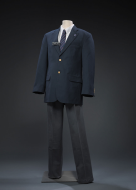 /tiles/non-collection/1/1origins_2005uniform_2005_198_001PQ1_dark.xml
/tiles/non-collection/1/1origins_2005uniform_2005_198_001PQ1_dark.xml
The dress of House Pages evolved over the years to this final iteration from 2005: a navy blazer, grey trousers, white shirt, and a red, white, and blue striped tie. Comfortable shoes were not issued, but suggested in the dress code, as the Page’s days often included multiple circuits around the Capitol complex, running errands for Members. This standardized look was codified by the 1980s, and it made the teenage workers easily identifiable in the Capitol.
Collection of the U.S. House of Representatives, Gift of Marshall Wills
About this object
National Fraternity of Pages Pin
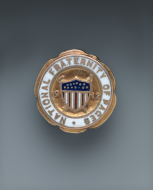 /tiles/non-collection/2/2005_214_001PQ1.xml
/tiles/non-collection/2/2005_214_001PQ1.xml
This Page fraternity pin dates from the early days of the Page School. It seems, though, that the National Fraternity of Pages predates the founding of the school in 1931. The former owner of the pin speculated that the “1912” on either side of the shield may indicate the founding date of the organization as well as the year of the pin. Pages were introduced into the Capitol in the 1840s.
Collection of the U.S. House of Representatives, Gift of Glenn Rupp
About this object
The Hall of the House of Representatives
 /tiles/non-collection/2/2004_085_015-2.xml
/tiles/non-collection/2/2004_085_015-2.xml
Illustrations such as this example of the House Chamber from 1884 were common features of travel guidebooks throughout the 19th century. Specific details, such as the two large landscape paintings by Albert Bierstadt and the portraits of George Washington and the Marquis de Lafayette, are clearly shown in this image, which would help prepare tourists for their visit to the Capitol.
U.S. Capitol Page School Handbook
 /tiles/non-collection/2/2002_023_003q.xml
/tiles/non-collection/2/2002_023_003q.xml
Qualifications for admission, dress code, class descriptions, job duties, and extracurricular activities—all aspects of life as a Page—are addressed in this 1961 handbook. While primarily factual, interesting indications of the changing times can be found in the handbook, such as the passing line that “in the Supreme Court the former rule of a page being only 5 feet 4 inches in height or no taller than the high-backed chairs of the Justices is no longer enforced.”
Collection of the U.S. House of Representatives, Jim Oliver Collection
About this object
U.S. House of Representatives Page Call System Card
 /tiles/non-collection/2/2002_023_001q.xml
/tiles/non-collection/2/2002_023_001q.xml
The call system was an important part of the modern House Page’s work experience, and this 1985 card from the Republican side provided a guide to decoding the signals. While staffing the Chamber, Pages sat in the back on the Page’s bench, waiting to be called for errands. Buttons between the Members’ seats, when pushed, lit up a switchboard near the Page bench, indicating that one of two seat numbers had requested them. A request from the Speaker was indicated by a red light. The card reflects the seat number pattern of the switchboard.
Collection of the U.S. House of Representatives, Jim Oliver Collection
About this object
The Capitol Courier
 /tiles/non-collection/2/2002_025_001q.xml
/tiles/non-collection/2/2002_025_001q.xml
The Page School had many of the hallmarks of other high schools. This edition of The Capitol Courier in 1954 was a four-page newsletter with headlines such as “Senate Gavel History Dates Back to 1774.”
Collection of the U.S. House of Representatives, Jim Oliver Collection
About this object
Page School Scholastic Letter
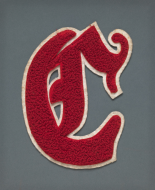 /tiles/non-collection/2/2007_151_002PQ1.xml
/tiles/non-collection/2/2007_151_002PQ1.xml
This embroidered “C” was one of the Capitol Page School’s first varsity letters for scholastics in 1946. Formal schooling for Pages, the boys who served as messengers in the Congress, had been evolving since 1926. A space was set up in the basement of the Capitol and a limited number of Pages began to attend classes at the private, tuition-based facility.
Collection of the U.S. House of Representatives, Gift of Charles Hill Anderson
About this object
The Hall of Representatives in the New Extension of the Capitol at Washington (detail)
 /tiles/non-collection/2/2003_034_000q.xml
/tiles/non-collection/2/2003_034_000q.xml
This 1858 print showing the details of the newly completed House Chamber, which had opened just months before, is also the earliest image of Pages in the House Collection. Small boys can be seen sitting alongside the lowest level of the three-tiered Speaker’s rostrum. By the late 1850s, Pages had been working in the Capitol for nearly half a century.
Collection of the U.S. House of Representatives
Grade Book of the Congressional Page School
 /tiles/non-collection/2/2004_017_002q.xml
/tiles/non-collection/2/2004_017_002q.xml
Although Pages began serving Congress in the 1840s, a school for these young workers was not established until 1931. The organization of the school formalized and modernized the tradition and allowed students from around the country to participate without interrupting their education. This grade book documents the progress of the students in the 1948–1950 school years.
Collection of the U.S. House of Representatives, Jim Oliver Collection
About this object
Counting the Electoral Vote - David Dudley Field Objects to the Vote of Florida
 /tiles/non-collection/2/2005_106_000.xml
/tiles/non-collection/2/2005_106_000.xml
The process of resolving the disputed 1876 presidential election is illustrated in this 1877 wood engraving. Florida was one of four states that sent two sets of inconsistent returns to Congress. David Dudley Field, who served a single term in Congress, objects to Florida’s returns in a packed Chamber. The newly formed Electoral Commission is seated facing the rostrum, which is populated not only by the usual officials, but also a group of exhausted and distracted Pages.
Capitol Building Pass
 /tiles/non-collection/2/2005_214_002-1.xml
/tiles/non-collection/2/2005_214_002-1.xml
Glenn Rupp, a House Page from 1932 to 1936, was issued this pass for President Herbert Hoover’s 1932 address to a Joint Session of Congress marking the bicentennial of George Washington’s birth. Pages often had access to memorable events at the Capitol.
Collection of the U.S. House of Representatives, Gift of Glenn Rupp
About this object
Page Pin
 /tiles/non-collection/2/2007_118_000.xml
/tiles/non-collection/2/2007_118_000.xml
Pages in 1930 could wear these lapel pins with their prescribed dark blue suits to help identify them around the Capitol. A more complex design than the average uniform lapel pin, an enamel shield decorated with stars and stripes surrounded by a gold-colored border, indicated that the Page wearing it worked in the House of Representatives. A relief eagle crouches above the shield, and the Capitol dome surmounts the composition. Thin links attach a pendant indicating the date of service.
A Scene in the Hall of Representatives Washington
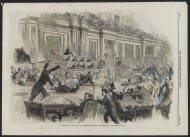 /tiles/non-collection/2/2006_106_003.xml
/tiles/non-collection/2/2006_106_003.xml
This scene from 1861 illustrates the contentious House on the eve of the Civil War. The accompanying article described how different it was from the British House of Commons, noting that “sometimes our legislators are noisy and excited; but no one ever saw any of them exhibiting in such poses as are depicted in our illustration.” In the foreground, a Page bearing papers wears an expression of consternation as he looks toward the man lunging forward with a sweeping gesture. The Page can perhaps be interpreted as a stand-in for the viewer, looking with disapproval on the lack of propriety in the U.S. House.
Page School Varsity Letter
 /tiles/non-collection/2/2007_152_000PQ1.xml
/tiles/non-collection/2/2007_152_000PQ1.xml
In 1944, the Capitol Page School gave House Page Joe Bartlett, whose career as a House staffer ultimately spanned 38 years, a varsity letter in basketball. Pages attended school in the early morning, worked as messengers in the Capitol in during the day and in Bartlett’s case, played basketball in the evening. Bartlett recalled that the team was not championship material, and that his own contribution was modest: “My height was never in my favor.”
Collection of the U.S. House of Representatives, Gift of Brigadier General Joe Bartlett
About this object
The Congressional
 /tiles/non-collection/p/pages_2008_014.xml
/tiles/non-collection/p/pages_2008_014.xml
The fourth edition of the Page School’s yearbook, The Congressional reviewed the highlights of the 1945 school year, including the graduation, attended by First Lady Eleanor Roosevelt and the christening of a Coast Guard helicopter that was purchased with funds from a Page War Bond Drive. Day-to-day life was also documented in photo montages showing classes in progress, a basketball game, and other scenes around the Capitol.
The Official Count of the Electoral Votes for President and Vice President, in the Hall of the Representatives, Feb. 9th
 /tiles/non-collection/2/2007_292_002q.xml
/tiles/non-collection/2/2007_292_002q.xml
Nineteenth-century news illustrations of important events in the Chamber often included the young Pages in the crowds they depicted. Striking in this 1881 example is how small and inconspicuous the boys seem in context, milling about the rostrum and the well—a reminder of the Supreme Court’s guideline that specified that the boys should not be taller than the chair backs in their Chamber.
The Congressional Staff Photo
 /tiles/non-collection/2/2007_151_005q.xml
/tiles/non-collection/2/2007_151_005q.xml
The student staff of the 1946 edition of The Congressional—the Page School’s yearbook—posed here with their staff advisor. Along with the Student Council and Honor Society, working on The Congressional was a way to earn points toward a scholastic letter. The editor received one letter, while staff earned between 5 and 25 points toward the 100 needed for the award.
Collection of the U.S. House of Representatives, Gift of Charles Hill Anderson
About this object
Page School Luncheon Photo
 /tiles/non-collection/2/2007_151_006q.xml
/tiles/non-collection/2/2007_151_006q.xml
This photo commemorates the Capitol Page’s May 4th, 1946, luncheon with President and Mrs. Truman. The event is described in detail in The Congressional yearbook, including the menu, which included cream of mushroom soup, fried chicken, and an unidentified “yellow food.” The boys were also treated to a viewing of the not-yet-released John Wayne film Badman’s Territory in the White House theater.
Collection of the U.S. House of Representatives, Gift of Charles Hill Anderson
About this object
Rubber Band Ball
 /tiles/non-collection/2/2002_003_000.xml
/tiles/non-collection/2/2002_003_000.xml
Rubber bands have been stretched one upon another to form balls for generations, but this example is unusual. It was created by Pages in 2002, over the course of many late-night debates in the House Chamber. It was kept near the speaking lecterns, and while Members of Congress were waiting to speak, they sometimes bounced the ball. Eventually this stress-busting activity was forbidden because it jostled nearby equipment.
Page Dress Code Booklet
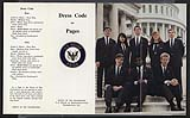 /tiles/non-collection/2/2007_183_073.xml
/tiles/non-collection/2/2007_183_073.xml
In earlier handbooks, acceptable dress was described as simply a dark blue suit, white shirt, black socks, shoes and tie. By the mid-1980s, the Page dress code was completely standardized, for boys and girls. Here, acceptable clothing items are described and illustrated. While there was some room for interpretation with the cut of trousers, jackets and skirts, everyone was issued a tie, creating a consistent and instantly recognizable look for the Pages.
Collection of the U.S. House of Representatives, Jim Oliver Collection
About this object
Sketches in the House of Representatives
 /tiles/non-collection/2/2007_345_005.xml
/tiles/non-collection/2/2007_345_005.xml
Edward W. Kemble sketched these Representatives in the House Chamber and the halls and retiring rooms nearby in a montage format commonly seen in illustrated newspapers. Some of these sketches, including this 1887 example, have a slight comedic turn, mixing straightforward illustrations of the Speaker with cartoonish images of hefty Members slumped in chairs and a small Page boy toting a heap of books he strains to peek over.
Washington, D.C. - The National Legislature - The Sergeant-at-Arms Bringing in Absentee Members
 /tiles/non-collection/2/2008_033_005.xml
/tiles/non-collection/2/2008_033_005.xml
Newspapers from this period inform us that a scene such as this was not uncommon during night sessions of the House. “However faithful members may be in the performance of their duties during the day sessions, they are very apt to recognize the claims of “society” in the evening.” Here, in 1881, the Sergeant at Arms, with the House Mace held aloft, led Members retrieved from dinners, receptions, and other social events back to the Chamber in order for the House to achieve a quorum.
Frank Mitchell
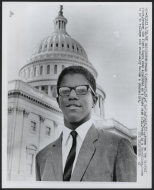 /tiles/non-collection/2/2008_188_001.xml
/tiles/non-collection/2/2008_188_001.xml
Appointed on April 14, 1965, Frank Mitchell became the first African American in the 20th century to serve as a Page in the House of Representatives. Congressman Paul Findley of Mitchell’s home state of Illinois recommended the 15-year-old for the appointment.
Collection of the U.S. House of Representatives, Photography Collection
About this object
The Opening of Congress - Characteristic Sketches
 /tiles/non-collection/2/2008_251_002q.xml
/tiles/non-collection/2/2008_251_002q.xml
Illustrated news journals often gave readers an assortment of scenes from the Capitol at the start of a new Congress. House Chaplain William Milburn is the most polished of the illustrations on this page from 1892. Blind for decades, Milburn relied on House Pages like the one in this image to assist him through the bustling throng in the House Chamber.
Frank Mitchell With Republican Leadership
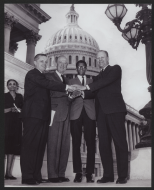 /tiles/non-collection/2/2008_273_000.xml
/tiles/non-collection/2/2008_273_000.xml
Frank Mitchell, the first African American appointed to the House Page Program in the modern era, is shown in 1965 with Representatives Paul Findley, Leslie Arends, and Gerald Ford (left to right). Congressman Findley, who represented Mitchell’s home district in Illinois, made the historic appointment.
Collection of the U.S. House of Representatives, Photography Collection
About this object
Among the Lawmakers
 /tiles/non-collection/2/2008_288_000.xml
/tiles/non-collection/2/2008_288_000.xml
The 1886 book Among the Lawmakers combined a memoir of a Senate page and a children’s textbook on government. The author interspersed descriptions of how the various branches of government function with colorful descriptions of his experience as a Senate page.
Tobogganing Extraordinary
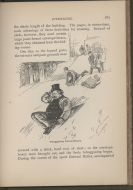 /tiles/non-collection/2/2008_288_000-13.xml
/tiles/non-collection/2/2008_288_000-13.xml
The off-duty diversions of the Pages were also described in Among the Lawmakers in 1886, and in this example, Representative Benjamin Butler joins them in a sledding excursion. After sharing a paste-board box-envelope with the “portly Representative,” the pages “gave him a vigorous shove, and down he went with lightening swiftness.” The journey was not all smooth, however: “as with increased momentum, he struck the second terrace, the box parted, and with terrific speed, he finished the trip—all by himself. And he was still going when lost in the distance of the park.”
Among the Lawmakers (detail)
Collection of the U.S. House of Representatives
About this object
Her Legal Advisor
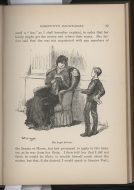 /tiles/non-collection/2/2008_288_000-4.xml
/tiles/non-collection/2/2008_288_000-4.xml
Pages often delivered the calling cards of individuals seeking to request government assistance from their Members of Congress. Regarding this interaction with adults, the former Page writing in this 1886 book said that “My duties threw me among people of all grades and conditions, from the President of the United States to the humblest person in the land; but amid all vicissitudes, I vigilantly endeavoured to maintain the dignity of my office as a senatorial ambassador.”
Among the Lawmakers (detail)
Collection of the U.S. House of Representatives
About this object
The Last Speech on Impeachment - Thaddeus Stevens Closing the Debate in the House
 /tiles/non-collection/2/2009_129_001.xml
/tiles/non-collection/2/2009_129_001.xml
News journals like Harper’s Weekly were so riveted by the nation’s first presidential impeachment that they documented even the minutiae of its progress. These 1868 illustrations showed A. G. Burr sleeping through John Chanler’s “loud, shrill” speech on an appropriations bill; reporters sprinting to the telegraph office as soon as the impeachment articles were published; and what was regarded as the last speech of the leader of the impeachment forces, the ailing Thaddeus Stevens, which brought Members, reporters, and even young Pages to rapt attention.
Page School Class Photograph
 /tiles/non-collection/2/2009_212_007q.xml
/tiles/non-collection/2/2009_212_007q.xml
The student body of the Page School and their instructors posed on the East Front lawn of the Capitol in this large format photograph taken in 1947. The variations in dress acceptable at the time can all be seen here. Seated in the front row on the left, the Supreme Court Pages wear their mandated knickers and jackets. The House Pages had fewer dress restrictions, and wear a variety of fashionable sport coats and suits for the photo.
Collection of the U.S. House of Representatives, Photography Collection, Jim Oliver Collection
About this object
Scenes at the Capitol and on Pennsylvania Ave.
 /tiles/non-collection/2/2010_34.xml
/tiles/non-collection/2/2010_34.xml
This 1884 article from Frank Leslie’s Illustrated Newspaper shows scenes of daily business in the capital, from Speaker Carlisle calling the House to order and swearing in “potent, grave and reverend legislators” to the dangers faced by a Congressman in an unfamiliar city. For example, at right, a new Member of Congress finds himself so lost in the vast Capitol that he asks directions from a “small boy, who seems as if he had been born and raised in the building.”
Glimpses of the Opening Days of Congress
 /tiles/non-collection/2/2011_089_003.xml
/tiles/non-collection/2/2011_089_003.xml
The opening day of Congress has long been a festive time in the House. This set of sketches shows a few of the highlights of the day in 1900. New Members are sworn in at lower left; at top right, a blindfolded Page draws numbers in the lottery to choose desks in the Chamber while flowers are delivered to Members as they find their new seats.
Speech Subscription Sheet
To
earn extra cash, 19th century Pages collected lists like this one, with the
names of Representatives seeking copies of particularly fine House speeches.
Collection of the U.S. House of Representatives, Jim Oliver Collection
About this object
House Pages
In the first part of the 20th century, some of the House Pages gathered on the
steps of the Capitol for a group photo.
Collection of the U.S. House of Representatives, Jim Oliver Collection
About this object
House Pages
Twenty-nine Pages jostled each other on the House rostrum as they lined up for a photo in the early 20th century.
Collection of the U.S. House of Representatives, Jim Oliver Collection
About this object
 /tiles/non-collection/2/2008_155_000PQ1.xml
/tiles/non-collection/2/2008_155_000PQ1.xml
 /tiles/non-collection/2/2011_086_002PQ1.xml
/tiles/non-collection/2/2011_086_002PQ1.xml
 /tiles/non-collection/2/2005_214_001PQ1.xml
/tiles/non-collection/2/2005_214_001PQ1.xml
 /tiles/non-collection/2/2004_085_015-2.xml
/tiles/non-collection/2/2004_085_015-2.xml
 /tiles/non-collection/2/2002_023_003q.xml
/tiles/non-collection/2/2002_023_003q.xml
 /tiles/non-collection/2/2002_023_001q.xml
/tiles/non-collection/2/2002_023_001q.xml
 /tiles/non-collection/2/2002_025_001q.xml
/tiles/non-collection/2/2002_025_001q.xml
 /tiles/non-collection/2/2007_151_002PQ1.xml
/tiles/non-collection/2/2007_151_002PQ1.xml
 /tiles/non-collection/2/2003_034_000q.xml
/tiles/non-collection/2/2003_034_000q.xml
 /tiles/non-collection/2/2004_017_002q.xml
/tiles/non-collection/2/2004_017_002q.xml
 /tiles/non-collection/2/2005_106_000.xml
/tiles/non-collection/2/2005_106_000.xml
 /tiles/non-collection/2/2005_214_002-1.xml
/tiles/non-collection/2/2005_214_002-1.xml
 /tiles/non-collection/2/2007_118_000.xml
/tiles/non-collection/2/2007_118_000.xml
 /tiles/non-collection/2/2006_106_003.xml
/tiles/non-collection/2/2006_106_003.xml
 /tiles/non-collection/2/2007_152_000PQ1.xml
/tiles/non-collection/2/2007_152_000PQ1.xml
 /tiles/non-collection/p/pages_2008_014.xml
/tiles/non-collection/p/pages_2008_014.xml
 /tiles/non-collection/2/2007_292_002q.xml
/tiles/non-collection/2/2007_292_002q.xml
 /tiles/non-collection/2/2007_151_005q.xml
/tiles/non-collection/2/2007_151_005q.xml
 /tiles/non-collection/2/2007_151_006q.xml
/tiles/non-collection/2/2007_151_006q.xml
 /tiles/non-collection/2/2002_003_000.xml
/tiles/non-collection/2/2002_003_000.xml
 /tiles/non-collection/2/2007_183_073.xml
/tiles/non-collection/2/2007_183_073.xml
 /tiles/non-collection/2/2007_345_005.xml
/tiles/non-collection/2/2007_345_005.xml
 /tiles/non-collection/2/2008_033_005.xml
/tiles/non-collection/2/2008_033_005.xml
 /tiles/non-collection/2/2008_188_001.xml
/tiles/non-collection/2/2008_188_001.xml
 /tiles/non-collection/2/2008_251_002q.xml
/tiles/non-collection/2/2008_251_002q.xml
 /tiles/non-collection/2/2008_273_000.xml
/tiles/non-collection/2/2008_273_000.xml
 /tiles/non-collection/2/2008_288_000.xml
/tiles/non-collection/2/2008_288_000.xml
 /tiles/non-collection/2/2008_288_000-13.xml
/tiles/non-collection/2/2008_288_000-13.xml
 /tiles/non-collection/2/2008_288_000-4.xml
/tiles/non-collection/2/2008_288_000-4.xml
 /tiles/non-collection/2/2009_129_001.xml
/tiles/non-collection/2/2009_129_001.xml
 /tiles/non-collection/2/2009_212_007q.xml
/tiles/non-collection/2/2009_212_007q.xml
 /tiles/non-collection/2/2010_34.xml
/tiles/non-collection/2/2010_34.xml
 /tiles/non-collection/2/2011_089_003.xml
/tiles/non-collection/2/2011_089_003.xml



 ;
;
 ;
;
 ;
;
 ;
;
 ;
;
 ;
;
 ;
;
 ;
;
 ;
;
 ;
;
 ;
;
 ;
;
 ;
;
 ;
;
 ;
;
 ;
;
 ;
;
 ;
;
 ;
;
 ;
;
 ;
;
 ;
;
 ;
;
 ;
;
 ;
;
 ;
;
 ;
;
 ;
;
 ;
;
 ;
;
 ;
;
 ;
;
 ;
;